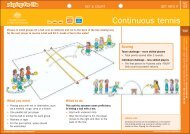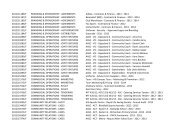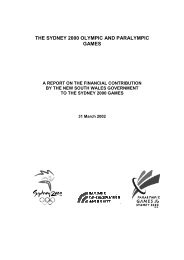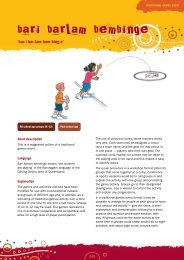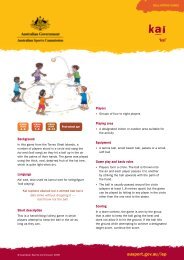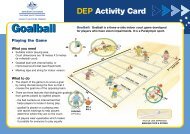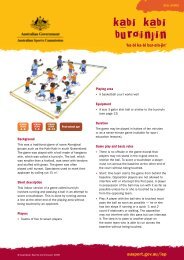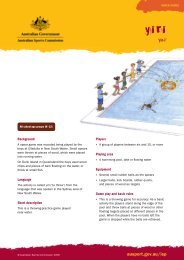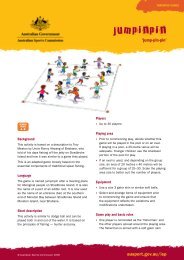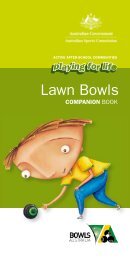aurukun - Australian Sports Commission
aurukun - Australian Sports Commission
aurukun - Australian Sports Commission
You also want an ePaper? Increase the reach of your titles
YUMPU automatically turns print PDFs into web optimized ePapers that Google loves.
School<br />
YearS<br />
4–6<br />
School<br />
YearS<br />
7–9<br />
School<br />
YearS<br />
10–12<br />
Post-school age<br />
Background<br />
This game comes from the Aurukun Aboriginal<br />
community in north Queensland, where it is known<br />
as ‘bat and ball’. It is a modern game that has links<br />
to traditional hitting games of Aboriginal people in<br />
the area. It is the most popular of all the games<br />
played at Aurukun and can usually be seen being<br />
played at lunch time in schoolyards. However, it is<br />
usually played in the afternoons around the streets<br />
when it is cooler and the sun has begun to set. This<br />
game is outlined on the authority of Herbert Hudson<br />
and Stanley (Bo) Ngakyumkwokka, both students of<br />
the Aurukun Community School.<br />
Language<br />
The name of the game has been taken from the<br />
town of Aurukun, where the game was observed<br />
being played.<br />
Short description<br />
In this bat-and-ball game players in teams take<br />
turns and attempt to hit a ball back and forth.<br />
Players<br />
• Numbers are unrestricted for this activity.<br />
Playing area<br />
• A large open area such as a cricket oval is<br />
suitable. The more players the larger the<br />
area required.<br />
BALL-ROLLING GAMES<br />
<strong>aurukun</strong><br />
‘aru-kun’<br />
Equipment<br />
• Equipment required is minimal; simply a tennis<br />
ball and ‘bats’ (sticks) such as Kanga cricket<br />
stumps. Less-skilled or younger players may use<br />
a small bat or racquet. Each player has his or her<br />
own ‘bat’.<br />
© <strong>Australian</strong> <strong>Sports</strong> <strong>Commission</strong> 2008 ausport.gov.au/isp
Game play and basic rules<br />
• The idea of the game is to create a fast forwardand-back<br />
momentum of the ball in a tennis-like<br />
fashion. Players in a team rotate turns. Play can<br />
be designed to make it a continuous fun activity<br />
or teams may attempt to win each round or turn.<br />
• Players are divided into two teams separated by<br />
a middle line (usually unmarked, for example,<br />
using two trees or similar structures).<br />
• Once the teams have been chosen, four to six<br />
players from each side stand in single file, with<br />
a space between players of approximately 1.5 to<br />
2 metres. The heads of the line of players face<br />
each other 5–10 metres back from the middle or<br />
separation line. If there are more than six players<br />
in each team the remainder on each team stand<br />
well behind the line of players and close to the<br />
playing area boundaries to act as ‘back stops’.<br />
These players swap into the game.<br />
• To begin the game the ball is thrown underarm<br />
from the front player of one line to the front<br />
player of the other. This throw must bounce at<br />
least once before reaching the hitter and once<br />
the ball is in hitting range the player attempts to<br />
strike it.<br />
• Regardless of whether this player makes contact<br />
with the ball, fails to hit it, or hits it and the ball<br />
does not clear the middle/separation line, the<br />
hitter immediately rotates, either to the back<br />
of the single line of players or to a back-stop<br />
position, depending on the number of players.<br />
• The ball is in play when it clears the middle/<br />
separation line. The player who first threw the ball<br />
attempts to contact the ball and after his or her<br />
turn rotates to the end of his or her team’s line.<br />
• Note: The ball may bounce more than once but is<br />
‘out of play’ once it is rolling. When this occurs it<br />
is picked up and thrown to the front player of the<br />
appropriate line to re-commence play.<br />
• If a thrown or hit ball is missed by the front player<br />
in the line the player directly behind him or her<br />
is able to attempt a strike and so on down the<br />
line until either the ball starts rolling or a player<br />
makes contact to keep the ball in play. Players<br />
should move out of the way if they miss the ball<br />
to allow the players behind them the chance to<br />
hit the ball.<br />
• A receiver/hitter is allowed to control the ball by<br />
either bouncing the ball with the bat similar to<br />
bouncing a basketball or by hitting/volleying the<br />
ball up in the air and then hitting it, comparable<br />
to lifting/juggling a soccer ball and then kicking it<br />
to another player.<br />
• If the ball travels past all the players in the line<br />
the backstops come into play and they either hit<br />
the ball back to the opposition to keep the ball in<br />
play or for safety simply retrieve the ball for the<br />
next round.<br />
• Disputed possession: If the ball stops on the<br />
separation line the two head players of each line<br />
move forward to perform the act of ‘Hockey 1,<br />
hockey 2, hockey 3’. The players stand facing<br />
each other separated by the middle line with<br />
their bats and feet either side of the ball. On the<br />
call of ‘Hockey 1’ the players clap sticks in the<br />
middle above the ball, and then they return their<br />
sticks to the starting position. This continues<br />
until ‘Hockey 3’ when, after clapping or hitting<br />
sticks in the middle, players attempt to ‘win’<br />
the ball for their team.<br />
Variations<br />
• A volleyball style of play could be introduced<br />
into the game, whereby each side is allowed a<br />
maximum of three hits/volleys between players<br />
before hitting the ball to the other team.<br />
• Tennis-court play: Play with tennis racquets and<br />
ball. Use a tennis court with one player on the<br />
court at each end and the other players behind<br />
the baseline. After starting the game with an<br />
underarm hit the player joins the end of his or her<br />
group behind the baseline and is replaced by the<br />
next player. Play as a continuous rally or attempt<br />
to score a point.<br />
• Teams alternate roles to start a new turn/round.<br />
After a round has ended the team that previously<br />
hit the ball restarts with an underarm throw of<br />
the ball.<br />
• Introduce a scoring format into the game whereby<br />
each successful hit that is unplayable registers<br />
one point and award two points for a home run<br />
(outside the boundary on the ‘full’). Play the<br />
first to ten.
Comment<br />
After each successful hit players usually clap sticks<br />
in a ‘high five’ type fashion in celebration of the<br />
achievement and to reinforce team spirit.<br />
Safety<br />
Players should be reminded of the danger<br />
associated with the swinging of bats when other<br />
players are standing nearby. It is important always<br />
to enforce the 1.5–2-metre separation of players<br />
standing in single file. Effectively survey the playing<br />
area prior to commencement and be sure to remove<br />
any potentially dangerous obstructions.<br />
Teaching points<br />
• Two teams.<br />
•<br />
•<br />
•<br />
•<br />
•<br />
•<br />
•<br />
Spread out. Ready.<br />
Roll in turns. Who’s first?<br />
Bend down. Fingers towards palm up.<br />
Good work.<br />
Stop the ball with the sole of your foot.<br />
Next turn.<br />
Keep going.



